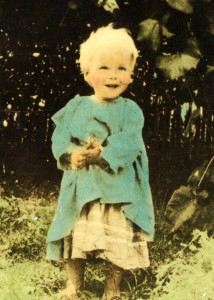 As I revise the new NEHGS Guide to Genealogical Writing (2014), I’ve been thinking ahead to a future project of my own: writing my family’s history. Having edited and produced a number of compiled genealogies at NEHGS, I have the genealogical format down cold. That’s the easy part. But what will I include for narrative information, to help bring the stories to life?
As I revise the new NEHGS Guide to Genealogical Writing (2014), I’ve been thinking ahead to a future project of my own: writing my family’s history. Having edited and produced a number of compiled genealogies at NEHGS, I have the genealogical format down cold. That’s the easy part. But what will I include for narrative information, to help bring the stories to life?
This question leads me back to a favorite document, a piece of notebook paper on which I recorded notes of a conversation with my father sometime in the early 1990s.
Born in 1909 as one of nine children, Dad grew up on a 99-acre farm in Pennsylvania. Times were tough; he had to leave school after eighth grade to help support the family. When tuberculin testing of cows began in the 1920s, many of the farm’s cattle tested positive. Dad remembered driving 100 head of cattle ten miles down the road to the slaughterhouse in Erie.
The farm never recovered. My grandfather tried to get a job in a mill, but – my notes say – “Mill wouldn’t give him a job because he was over 40.” Hearing of work in the Warren-Youngstown, Ohio, area, the family moved there in 1928. At 19, Dad got a job with Ohio Public Service (later Ohio Edison), a regional power company. When the Depression hit, he was laid off for several years – and finally got a job doing steel work for 20 cents an hour. Ohio Public Service hired him back, and although the wages weren’t as high as elsewhere, there was good job security. He ended up staying there for more than 40 years.
The notes give me further details – how Grandma and the kids accidentally let the potato crop freeze, how the farm neighbors took turns hauling milk to town on wagons, what Dad paid for a new suit in 1929 ($7.50) – and I treasure them because of the picture I get of Dad and his family. But now, having read so many other family histories, I also see how Dad fits into the larger picture of American history: the move from farm to industry, the privation of the Depression – and the now seemingly unusual practice of staying with the same company for decades. To me, this picture of twentieth-century life is as interesting as details of the lives of my earlier ancestors. I wish now I’d interviewed my father again, and again. Or my aunts and uncles, all of them now gone. Having learned that lesson, I’ve been urging my husband to interview his 98-year-old mother . . . with a video camera, so we capture her image and her voice, along with her memories.
Share this:
About Penny Stratton
A veteran of the book publishing industry, Penny Stratton retired as NEHGS Publishing Director in June 2016; she continues to consult with the Society on publications projects. Among the more than 65 titles she managed at NEHGS are The Great Migration Directory, Elements of Genealogical Analysis, Genealogist’s Handbook for New England Research, and the award-winning Descendants of Judge John Lowell of Newburyport, Massachusetts. She has written for American Ancestors magazine and is a regular poster on Vita Brevis. With Henry B. Hoff, Penny is coauthor of Guide to Genealogical Writing: How to Write and Publish Your Family History; she is also the author of several Portable Genealogists on writing and publishing topics.View all posts by Penny Stratton →